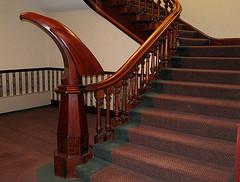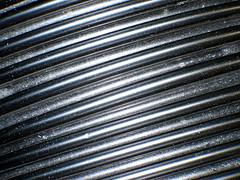 Selection of wood is carried out in such a way that the loss or deformation of the fragments of the laid tile package even if Inappropriate changes in temperature and humidity is completely eliminated. Flooring, in contrast to the parquet – a multi-layered structure consisting of three layers. Upper (from 3,0 mm to 6 mm) made of solid fine wood. The middle layer is a spruce or pine blocks, arranged so that their fibers are directed perpendicular to the axis of the upper layer. Bottom stabilizing layer is made of plywood or veneer softwood.
Selection of wood is carried out in such a way that the loss or deformation of the fragments of the laid tile package even if Inappropriate changes in temperature and humidity is completely eliminated. Flooring, in contrast to the parquet – a multi-layered structure consisting of three layers. Upper (from 3,0 mm to 6 mm) made of solid fine wood. The middle layer is a spruce or pine blocks, arranged so that their fibers are directed perpendicular to the axis of the upper layer. Bottom stabilizing layer is made of plywood or veneer softwood.
All elements of the floorboards are glued together using a special water resistant adhesive which provides a uniform covering layer and strong adhesion of all layers. Such a structure floorboard minimizes its warping and changing humidity and temperature in the room. Parquet board is made of varying thickness – from 8,5 to 22 mm, the most popular size of 14 and 15 mm in the thickness of the layer 3.5 mm. The width of solid wood ranges from 100 mm to 200 mm and the length of 1,2-3 meters. As a rule most popular uses material length 1.2 and 2 meters in width from 120 to 140 mm. Massive board has a tongue-groove, and on the perimeter of its upper edges blunted width of 0.5 mm, which allows you to hide the possible gap between the boards, resulting in adverse microclimatic conditions.
Board made of wood can be delivered without the protective and decorative coatings, so-called polished, or already covered with paint, oil or wax. In the second case, the material does not require sanding and finishing after installation, this board should just stick to a pre-prepared base. Because the sand hardwood boards with a thickness of 3.6 mm of the working layer can be up to five times, then such a floor covering can last for more than twenty years. Wood used for the manufacture of flooring, are divided by the hardness of the soft (birch, cherry), average (oak, merbau, ash) and solid (ebony, Jatoba). Hardness – measure attrition useful layer parquet, the higher it is, the more durable flooring. In addition, the stability of timber is important, ie how a particular wood rock is deformed by changes in temperature and humidity. Here comes first tick, then merbau, followed by oak, but enough solid beech because of its sensitivity to changes in air humidity is moody material. Wear resistance of wood depends on its density, the higher the density of wood, the greater its durability. However, for lacquered floors wear usually does not play a significant role. as they are additionally protected by layers of varnish which is depreciated to bare wood should not be tolerated.

 Elegant and comfortable car Peugeot 206 is designed and put into production in 1998. Even the most distant from the cars people can see the superiority of the car over other models. Because of its popularity edition Peugeot 206 model continued for several more years after the start of production in 2006, the new Peugeot 207. The first models of cars introduced to the market in 1998, upgrading a model 206 first awarded in 2003 This car is offered in two versions: with a third 5-door hatchback bodywork and station wagon. Also, based on the Peugeot 206 coupe-cabriolet was issued under the code name "206 SS" (discontinued in 2007). The car came with a two petrol (1.4 liters and 75 liters.., 1.6 liters and 109 hp..) And two diesel (1.4 liter and 65 years. with., 1.6-liter and 109 liter.
Elegant and comfortable car Peugeot 206 is designed and put into production in 1998. Even the most distant from the cars people can see the superiority of the car over other models. Because of its popularity edition Peugeot 206 model continued for several more years after the start of production in 2006, the new Peugeot 207. The first models of cars introduced to the market in 1998, upgrading a model 206 first awarded in 2003 This car is offered in two versions: with a third 5-door hatchback bodywork and station wagon. Also, based on the Peugeot 206 coupe-cabriolet was issued under the code name "206 SS" (discontinued in 2007). The car came with a two petrol (1.4 liters and 75 liters.., 1.6 liters and 109 hp..) And two diesel (1.4 liter and 65 years. with., 1.6-liter and 109 liter.  Let's look at some types of electrode which is used in ground facilities: The electrode in Lhasa natural lands. – Rod: with a cross, to angles. – Rehilete: two copper plates and welded cross. – Plate: You must have an area of at least 2000cm square and a thickness of approx. 6.4mm to 1.52mm in ferrous and nonferrous materials. – Star: In this type of electrode gives a value of less resistance. – Grid: arming a link is formed of bare copper conductors.
Let's look at some types of electrode which is used in ground facilities: The electrode in Lhasa natural lands. – Rod: with a cross, to angles. – Rehilete: two copper plates and welded cross. – Plate: You must have an area of at least 2000cm square and a thickness of approx. 6.4mm to 1.52mm in ferrous and nonferrous materials. – Star: In this type of electrode gives a value of less resistance. – Grid: arming a link is formed of bare copper conductors.